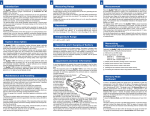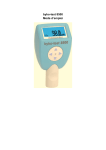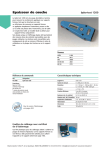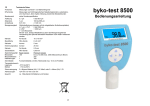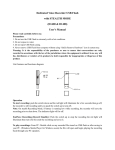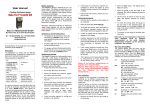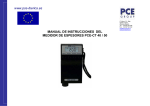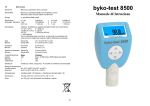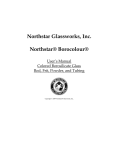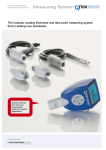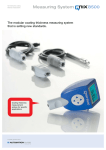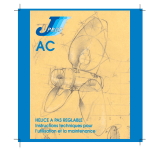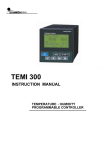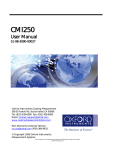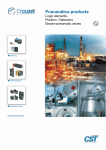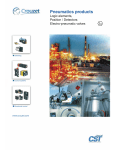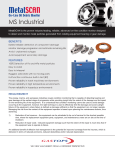Download Instruction Manual
Transcript
4 Technical Data Instruction Manual System Description ® Substrate Iron or steel ® QuaNix 4500 includes: Non-magnetic metals, e.g. aluminum, zinc, copper, brass Fe-probe NFe-Probe Measuring range Resolution resp. Accuracy Minimum object size Minimum curvature convex concave Minimum substrate thickness resp. Fe NFe 0 - 999 µm or 0.00 - 40 mil 1 µm 0.01 mil up to 9.99 mil 0.1 mil from 10 to 40 mil +/- (2 µm + 3%) +/- (0.08 mil + 3 %) 10 x 10 mm² (0.4"x0.4") 6x6 mm² (0.24"x0.24") 5 mm (0.02") 30 mm (1") Fe NFe Temperature range Storage Operation Probe Power supply Dimensions ca. Weight ca. 0.20 mm (8 mil) 0.05 mm (2 mil) -10°C to 60°C (14°F to 140°F) 0°C to 60°C (32°F to 140°F) One-point 2 batteries AA alkaline 100 x 62 x 27 mm (3.9" x 2.4“ x 1.1“) 100 g (3.5 oz) incl. batteries Internet: www.automation.de E-Mail: [email protected] The QuaNix 4200 dry film thickness gauge measures all non-magnetic coatings such as lacquer, chromium, copper, zinc etc. on steel or iron. ® The QuaNix 4500 dry film thickness gauge additionally measures all insulating coatings such as lacquer, plastic, enamel, etc. on non-magnetic, metallic substrates, e.g. on aluminium, copper, brass or non-magnetic steel. Both gauges conform to national (DIN) and international (ISO, BS, ASTM) standards: DIN 50981, 50984 BS 5411 (3, 11), 3900 (C, 5) ISO 2178, 2360, 2808 ASTM B499, D1400 General This dry film thickness gauge was designed for various applications. Despite its rugged design it should be handled correctly to insure proper measurements at all time. Do not let it drop and protect it from dirt, dust, humidity, chemicals and aggressive vapours. After use please store the gauge in the protective case. As with all precision instruments large temperature variations can influence the measuring result. Please avoid direct solar irradiation and temperature shocks. Due to the physical measuring principles the measurements can be influenced by strong electromagnetic fields. Please stay away from e.g. transformers, high voltage lines or discharge sources. Do not take measurements on magnetized parts. Magnetic fields can affect the Femeasurements. Strong electromagnetic radiation can affect the NFemeasurements. The housing is resistant against most solvents. Use a soft damp cloth to clean the housing. Proper results can only be achieved with clean probes. Please regularly check the probe tips and remove any dirt and paint from the rubies If the gauge is not used for a long period, please remove the batteries from the gauge in order to prevent leakage that can damage the unit. In case of a malfunction of the instrument please do not try to repair it on your own. Our customer service will be happy to assist you. 2 Change of Batteries 3 Handling The battery compartment is on the rear side of the gauge. The battery should be exchanged when the "BAT"-sign appears on the right side of the display. Additional readings can still be taken even with the “BAT”-indication before the gauge shuts off. Note! Empty batteries should be disposed of properly. If possible, please use the appropriate method. Place the gauge evenly on the object to be tested. The reading is immediately shown on the display accompanied by a beep. Simultaneously you will also receive the information, which measuring method, Fe or NFe, is presently used in the gauge (important for gauges with Dual-Probe). Change of Unit µm/mil Display of the readings is factory preset to the unit which is common for the user (generally in µm). To change the unit from µm to mil or vice versa, place the gauge on any surface or simply take a measurement. While holding it placed, press the button for at least 3 seconds. The display will switch from one unit to the other. If the gauge was placed incorrectly or lifted off before termination of the measurement, or when being zeroed on a non-metallic substrate, an error message “Err“ is displayed. Readings that exceed the measuring range are indicated by the message “IΙFI” (infinite). The gauge switches on automatically when being placed on the surface and turns off automatically after about 10 seconds when no other measurement is taken. For measurements on rods or tubes etc. align the “V”-groove along the axis of the object to be tested. Zero-Adjustment Measurements with the Dual-Probe A new zero-adjustment is required when using the gauge for the first time, working with different materials, and after inserting a new battery. Place the gauge on one of the zero plates in the case. For the Fe-probe please take the steel plate; for the NFe-probe take the aluminum plate, when you want to measure on aluminum; or use a suitable uncoated Fe- or NFe-substrate. Please make sure the probe is placed perpendicular and evenly on the surface of the zero plate or on your uncoated substrate. If the value indicated is not within the basic tolerance, the gauge should be adjusted as follows: Place the gauge on the zero plate (substrate). Then press the button once. On the display a control number appears and a beep sounds. Then lift off the gauge at least 10 cm (4 inches) from the zero plate (substrate). A beep sounds and another control number appears. Now the zero-adjustment is completed. When repeating measurements on the same spot, the reading may not always be 0 µm or 0.00 mil, as the surface roughness, dirt, scratches etc. might cause variances. The QuaNix 4500 gauge combines both measuring methods for Fe and NFe in one probe. Switching from Fe to NFe or vice versa is done as follows: ® Switch on the gauge. The current measuring method is displayed on the left side of the LCD (e.g. Fe). Press the button for at least 3 seconds. The new measuring method is shown on the left side of the LCD (e.g. NFe). Display Messages Fe NFe Err IΙFI BAT = = = = = measurement on ferrous materials (steel or iron) measurement on non-ferrous substrates handling error wrong substrate, reading beyond measuring range battery is getting week, please exchange 2 Change of Batteries 3 Handling The battery compartment is on the rear side of the gauge. The battery should be exchanged when the "BAT"-sign appears on the right side of the display. Additional readings can still be taken even with the “BAT”-indication before the gauge shuts off. Note! Empty batteries should be disposed of properly. If possible, please use the appropriate method. Place the gauge evenly on the object to be tested. The reading is immediately shown on the display accompanied by a beep. Simultaneously you will also receive the information, which measuring method, Fe or NFe, is presently used in the gauge (important for gauges with Dual-Probe). Change of Unit µm/mil Display of the readings is factory preset to the unit which is common for the user (generally in µm). To change the unit from µm to mil or vice versa, place the gauge on any surface or simply take a measurement. While holding it placed, press the button for at least 3 seconds. The display will switch from one unit to the other. If the gauge was placed incorrectly or lifted off before termination of the measurement, or when being zeroed on a non-metallic substrate, an error message “Err“ is displayed. Readings that exceed the measuring range are indicated by the message “IΙFI” (infinite). The gauge switches on automatically when being placed on the surface and turns off automatically after about 10 seconds when no other measurement is taken. For measurements on rods or tubes etc. align the “V”-groove along the axis of the object to be tested. Zero-Adjustment Measurements with the Dual-Probe A new zero-adjustment is required when using the gauge for the first time, working with different materials, and after inserting a new battery. Place the gauge on one of the zero plates in the case. For the Fe-probe please take the steel plate; for the NFe-probe take the aluminum plate, when you want to measure on aluminum; or use a suitable uncoated Fe- or NFe-substrate. Please make sure the probe is placed perpendicular and evenly on the surface of the zero plate or on your uncoated substrate. If the value indicated is not within the basic tolerance, the gauge should be adjusted as follows: Place the gauge on the zero plate (substrate). Then press the button once. On the display a control number appears and a beep sounds. Then lift off the gauge at least 10 cm (4 inches) from the zero plate (substrate). A beep sounds and another control number appears. Now the zero-adjustment is completed. When repeating measurements on the same spot, the reading may not always be 0 µm or 0.00 mil, as the surface roughness, dirt, scratches etc. might cause variances. The QuaNix 4500 gauge combines both measuring methods for Fe and NFe in one probe. Switching from Fe to NFe or vice versa is done as follows: 4 Technical Data Display Messages Fe NFe Err IΙFI BAT = = = = = measurement on ferrous materials (steel or iron) measurement on non-ferrous substrates handling error wrong substrate, reading beyond measuring range battery is getting week, please exchange Instruction Manual ® Fe-probe NFe-Probe Measuring range Resolution resp. Accuracy Minimum curvature convex concave Minimum substrate thickness Switch on the gauge. The current measuring method is displayed on the left side of the LCD (e.g. Fe). Press the button for at least 3 seconds. The new measuring method is shown on the left side of the LCD (e.g. NFe). System Description Substrate Iron or steel ® QuaNix 4500 includes: Non-magnetic metals, e.g. aluminum, zinc, copper, brass Minimum object size ® resp. Fe NFe 0 - 999 µm or 0.00 - 40 mil 1 µm 0.01 mil up to 9.99 mil 0.1 mil from 10 to 40 mil +/- (2 µm + 3%) +/- (0.08 mil + 3 %) 10 x 10 mm² (0.4"x0.4") 6x6 mm² (0.24"x0.24") 5 mm (0.02") 30 mm (1") Fe NFe Temperature range Storage Operation Probe Power supply Dimensions ca. Weight ca. 0.2 mm (8 mil) 0.05 mm (2 mil) -10°C to 60°C (14°F to 140°F) 0°C to 60°C (32°F to 140°F) One-point 2 batteries AA alkaline 100 x 62 x 27 mm (3.9" x 2.4“ x 1.1“) 100 g (3.5 oz) incl. batteries Internet: www.automation.de E-Mail: [email protected] The QuaNix 4200 dry film thickness gauge measures all non-magnetic coatings such as lacquer, chromium, copper, zinc etc. on steel or iron. ® The QuaNix 4500 dry film thickness gauge additionally measures all insulating coatings such as lacquer, plastic, enamel, etc. on non-magnetic, metallic substrates, e.g. on aluminium, copper, brass or non-magnetic steel. Both gauges conform to national (DIN) and international (ISO, BS, ASTM) standards: DIN 50981, 50984 BS 5411 (3, 11), 3900 (C, 5) ISO 2178, 2360, 2808 ASTM B499, D1400 General This dry film thickness gauge was designed for various applications. Despite its rugged design it should be handled correctly to insure proper measurements at all time. Do not let it drop and protect it from dirt, dust, humidity, chemicals and aggressive vapours. After use please store the gauge in the protective case. As with all precision instruments large temperature variations can influence the measuring result. Please avoid direct solar irradiation and temperature shocks. Due to the physical measuring principles the measurements can be influenced by strong electromagnetic fields. Please stay away from e.g. transformers, high voltage lines or discharge sources. Do not take measurements on magnetized parts. Magnetic fields can affect the Femeasurements. Strong electromagnetic radiation can affect the NFemeasurements. The housing is resistant against most solvents. Use a soft damp cloth to clean the housing. Proper results can only be achieved with clean probes. Please regularly check the probe tips and remove any dirt and paint from the rubies If the gauge is not used for a long period, please remove the batteries from the gauge in order to prevent leakage that can damage the unit. In case of a malfunction of the instrument please do not try to repair it on your own. Our customer service will be happy to assist you.



